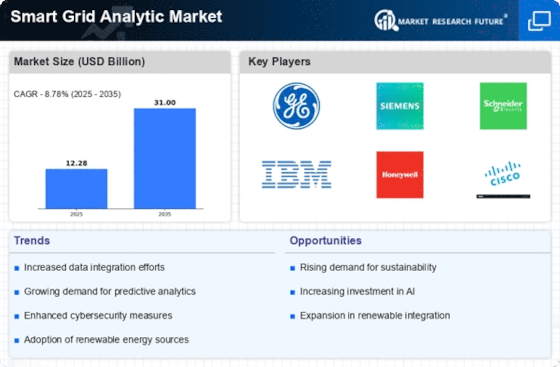Growing Demand for Energy Efficiency
The increasing demand for energy efficiency is a significant driver for the Smart Grid Analytic Market. As energy costs rise and environmental concerns mount, both consumers and businesses are seeking ways to reduce energy consumption. Smart grid analytics provides the tools necessary to identify inefficiencies and optimize energy usage. By leveraging data analytics, utilities can offer tailored solutions to consumers, promoting energy-saving behaviors. The market for energy efficiency technologies is projected to grow substantially, with smart grid analytics playing a central role in this transformation. In 2025, the emphasis on energy efficiency is expected to intensify, driven by both consumer demand and regulatory pressures. This trend not only benefits consumers through cost savings but also supports utilities in managing load and reducing peak demand, thereby enhancing grid stability. The interplay between energy efficiency and smart grid analytics is likely to shape the future of energy management.
Technological Advancements in Data Analytics
Technological advancements in data analytics are reshaping the Smart Grid Analytic Market. The emergence of sophisticated algorithms and machine learning techniques enables utilities to process vast amounts of data generated by smart grids. These advancements facilitate predictive analytics, which can forecast energy demand and identify potential outages before they occur. As of 2025, the market for data analytics in the energy sector is expected to witness significant growth, driven by the need for real-time insights and decision-making capabilities. The integration of artificial intelligence and big data analytics into smart grid systems enhances operational efficiency and customer engagement. Utilities are increasingly adopting these technologies to improve grid reliability and optimize resource allocation. The continuous evolution of data analytics tools is likely to propel the Smart Grid Analytic Market forward, fostering innovation and enhancing the overall performance of energy systems.
Regulatory Support for Smart Grid Initiatives
Regulatory support plays a crucial role in propelling the Smart Grid Analytic Market forward. Governments and regulatory bodies are increasingly recognizing the importance of smart grid technologies in achieving energy efficiency and sustainability goals. Policies that incentivize the adoption of smart grid solutions, such as tax credits and grants, are becoming more prevalent. In recent years, several countries have implemented frameworks that encourage utilities to invest in smart grid technologies, which in turn drives the demand for analytics solutions. The regulatory landscape is evolving to support the integration of renewable energy sources and enhance grid resilience. As of 2025, the regulatory environment is expected to continue favoring smart grid initiatives, thereby creating a conducive atmosphere for the growth of the Smart Grid Analytic Market. This support is likely to stimulate innovation and investment in analytics capabilities, further enhancing grid management.
Rising Investment in Smart Grid Infrastructure
Rising investment in smart grid infrastructure is a key driver for the Smart Grid Analytic Market. As utilities seek to modernize aging infrastructure, there is a growing emphasis on deploying smart grid technologies that enhance operational efficiency and reliability. Investments in smart grid projects are expected to increase significantly, with many countries prioritizing infrastructure upgrades to support renewable energy integration. By 2025, the financial commitment to smart grid initiatives is projected to reach impressive levels, reflecting the recognition of the benefits associated with smart grid analytics. These investments not only improve grid resilience but also create opportunities for analytics solutions that optimize energy distribution and consumption. The influx of capital into smart grid infrastructure is likely to stimulate innovation and drive the adoption of advanced analytics, ultimately transforming the energy landscape.
Integration of Advanced Metering Infrastructure
The integration of advanced metering infrastructure (AMI) is a pivotal driver for the Smart Grid Analytic Market. AMI facilitates real-time data collection and communication between utilities and consumers, enhancing operational efficiency. This technology allows for better demand response management and energy consumption monitoring. As of 2025, the AMI market is projected to reach substantial figures, indicating a growing reliance on smart meters. The data generated from these meters feeds into analytics platforms, enabling utilities to optimize energy distribution and reduce operational costs. Furthermore, the deployment of AMI supports the transition towards a more sustainable energy ecosystem, aligning with global energy policies aimed at reducing carbon footprints. The synergy between AMI and smart grid analytics is likely to foster innovation and improve service delivery in the energy sector.

















Leave a Comment